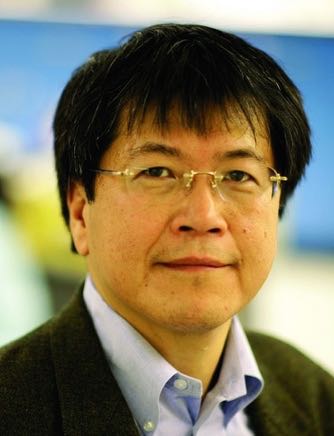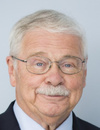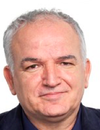Co-Located Conference AgendasPoint-of-Care Diagnostics & Global Health 2018 | Single Cell Analysis Summit 2018 |  Other Track Agendas Other Track AgendasLab-on-a-Chip and Microfluidics: Companies, Technologies and Commercialization "Track B" | Lab-on-a-Chip and Microfluidics: Emerging Themes, Technologies and Applications "Track A" |

Monday, 1 October 201813:00 | Conference Registration and Materials Pick-Up | |
Session Title: Congress Plenary Session |
| | |
Plenary Session Chairperson: Leanna Levine, Ph.D., Co-Founder & CEO, ALine, Inc. |
| | 14:00 |  | Keynote Presentation Wearable Microfluidic and Microtubular Sensors For Biomedical Applications
Chwee Teck Lim, NUS Society Chair Professor, Department of Biomedical Engineering, Institute for Health Innovation & Technology (iHealthtech), Mechanobiology Institute, National University of Singapore, Singapore
The future of healthcare wearables lies in continual sensing in an unobtrusive manner. Tactile sensing is especially important to capture mechanotransduced signals arising from the body, or as a result of interactions with the external environment. However, conventional sensors are rigid, stiff and obstrusive. Therefore, one of the key objectives is to confer flexibility and stretchability to our sensing elements, while maintaining its sensitivity and robustness. Here, we develop a novel liquid-based microfluidic and microtubular sensors that possess high flexibility, durability, and sensitivity. The sensors comprise a soft elastomer-based microfluidic template encapsulating a conductive liquid which serves as the active sensing element of the device. This sensor is capable of distinguishing and quantifying the various user-applied mechanical forces it is subjected to. We demonstrated biomedical applications of our sensors in rehabilitation monitoring, artificial sensing and disease tracking such as that for diabetic patients. Overall, our work highlights the potential of the liquid-based microfluidic sensing platform in a wide range of biomedical applications and further facilitates the exploration and realization of functional liquid-state device technology. |
| 14:30 |  | Keynote Presentation Wearable Microfluidics For Real-Time Personal Monitoring
Martyn Boutelle, Professor of Biomedical Sensors Engineering, Imperial College London, United Kingdom
Tissue functions at a cellular level by exchange of molecules either between cells and blood or between the cells themselves. This produces patterns of molecular change that are diagnostic of cellular processes whose origin can be physiological (exhaustion, pregnancy) or pathological (ischemia, renal failure, cancer). Our technologies have now developed to a point where we can aspire to do more than this, to measure from patients in real-time. The has the great benefit that it is them possible to understand the evolution of disease, the effectiveness of treatments, and ultimately to guide treatment. In this presentation I will describe the development of microfluidic devices connected to wireless electronics for transplant organ, patient and athlete monitoring. Tissue sampling is via an integrated microfluidic device, a microdialysis probe. Molecular biomarkers are measured using microscale integrated amperometric biosensors and solid-contact ion-selective electrodes (ISE) for tissue ionic balance. For detailed patterns of ionic responses we have developed high density Field Effect Transistor (FET) array which function as ISEs within the flow stream. We have also edevelodp multiphase flow microfluidic systems for highest time resolution.The presentation with describe the design and optimization challenges and include clinical examples from our recent work. |
| 15:00 |  | Keynote Presentation Advancing the Performance of Low Cost Diagnostics For Global Health
Bernhard Weigl, Director, Center for In-Vitro Diagnostics, Intellectual Ventures/Global Good-Bill Gates Venture Fund, United States of America
We will present lab and field results with recently developed lateral flow and similar assays for global health. Our group’s mission is to develop assays for use in global health applications that are as sensitive as the best conventional diagnostic assays (in some cases even better) while retaining cost, simplicity, and usability advantages. For our lateral flow assay work we have developed a 3D modeling platform for paper-based assays and are using it to determine the theoretical limit of a particular assay variant, as well as a rapid array-based empirical optimization system for lateral flow assays. Together, these approaches allow the development of more sensitive assays with shortened development time. We will describe the assay optimization methods we employ, as well the use of these methods in the development of several assays under development, including ones for malaria, and TB. |
| 15:30 |  | Keynote Presentation Absolute Quantification of Molecular Biomarkers
Hsueh-Chia Chang, Bayer Professor of Chemical and Biomolecular Engineering, University of Notre Dame, Interim Chief Technology Officer, Aopia Biosciences, United States of America
We report several micro/nanofluidic technologies we invented that can overcome the sensitivity obstacles for liquid biopsy: (1) A chip electrophoresis module for high-yield exosome extraction without centrifugation; (2) A Surface Acoustic Wave exosome lysing module that replaces chemical lysing and eliminates the need for low-yield solid/liquid miRNA extraction; (3) A solid-state polymer nanopore fM assay that can delay translocation of short 20-nt miRNAs and differentiate the duplexes that have hybridized with inserted oligos and the wild-type miRNAs; (4) A Carbon-Nanotube Protein Sensor with fM sensitivity, three orders of magnitude below KD. Integrated into a biochip, these technologies allow us to quantify protein biomarkers for breast cancer and miRNAs for pancreatic cancer, from patient blood samples, at sensitivities far better than CTC and current molecular biomarker assays, with dramatically improved AUC and p values. We have eliminated low-yield extraction steps and employed irreversible kinetics to achieve such high performances and have allowed absolute quantification without the need for house-keeping reference molecules. |
| 16:00 | Coffee Break and Networking | 16:30 |  | Keynote Presentation Nanosensors for Single-molecule Sequencing
Steve Soper, Foundation Distinguished Professor, Director, Center of BioModular Multi-Scale System for Precision Medicine, The University of Kansas, United States of America
We are generating a single-molecule DNA sequencing platform that can acquire sequencing information with high accuracy. The technology employs arrays of nanosensors that read the identity of individual mononucleotides from their characteristic electrophoretic mobility and current transient amplitudes through a 2-dimensional (2D) nanochannel (~20 nm in width and depth; <10 µm in length) fabricated in a thermoplastic via nano-imprinting (NIL). The mononucleotides are generated from an intact DNA fragment using a highly processive exonuclease, which is covalently anchored to a plastic solid support contained within a bioreactor that sequentially feeds mononucleotides into the 2D nanochannel. We will discuss the operation of this nanosensor in this presentation as well as its production.
|
| 17:00 |  | Keynote Presentation Quantum Diagnostics: From Single Cells to Single Molecules
Dino Di Carlo, Armond and Elena Hairapetian Chair in Engineering and Medicine, Professor and Vice Chair of Bioengineering, University of California-Los Angeles, United States of America
The ultimate limits of sensitivity in measuring biological systems occurs at the level of single-cells and single-molecules. I will discuss our approaches leveraging microfluidic and microfabrication technologies to interface at the scale of these single entities. In particular, we make use of the ability to compartmentalize fluid volumes to a sub-nanoliter scale and manipulate cells using unique microscale physics. I will discuss progress in using these quantized or digital measurements towards single-molecule infectious disease diagnostics, characterizing the immune evasion state of circulating tumor cells, and screening for drugs that modulate the contractile forces that single muscle cells apply. |
| 17:30 |  | Keynote Presentation Integrated Isolation, Detection and Analysis of cf-DNA and Exosome Biomarkers from Cancer Patient Blood Samples - The Road to POC Liquid Biopsy Diagnostics
Michael Heller, Professor, Dept Bioengineering, University of California-San Diego, United States of America
New AC electrokinetic (ACE) microarray/chip device allows 15-20-minute isolation of cancer related cf-DNA, exosomal RNA and protein biomarkers directly from 20-50ul of patient blood, plasma or serum. Cf-DNA levels can be immediately determined directly on the chip (in-situ) using DNA specific dyes and then immunofluorescent analysis can be carried out to identify exosomal protein biomarkers. Presently, cf-DNA and exosomal RNA are then eluted from the ACE chip, and PCR and sequencing analysis carried out to identify the cancer-related point mutations. New procedures are now being developed to carry out on-chip PCR for DNA/RNA analysis. On-chip integration of proteomic and genomic analysis is a major step forward in the quest for seamless sample to answer POC liquid biopsy diagnostics. |
| 18:00 |  | Keynote Presentation Cost-effective and Globally Deployable Mobile Diagnostics Using Paper-Based Nanobiosensors
Arben Merkoçi, ICREA Professor and Director of the Nanobioelectronics & Biosensors Group, Institut Català de Nanociencia i Nanotecnologia (ICN2), Barcelona Institute of Science and Technology (BIST), Spain
Point of care devices are progressing rapidly and the demand for cost
efficient globally deployable mobile diagnostics platforms is the key
factor for their success. Physical, chemical and mechanical properties
of cellulose in both micro and nanofiber-based networks combined with
their abundance in nature or easy to prepare and control procedures are
making these materials of great interest while looking for
cost-efficient and green alternatives for device production
technologies. Both paper and nanopaper-based biosensors are emerging as a
new class of devices with the objective to fulfil the “World Health
Organization” requisites to be ASSURED: affordable, sensitive, specific,
user-friendly, rapid and robust, equipment free and deliverable to
end-users. How to design simple paper-based biosensor architectures? How
to tune their analytical performance upon demand? How one can
‘marriage’ nanomaterials such as metallic nanoparticles, quantum dots
and even graphene with paper and what is the benefit? How we can make
these devices more robust, sensitive and with multiplexing capabilities?
Can we bring these low cost and efficient devices to places with low
resources, extreme conditions or even at our homes? Which are the
perspectives to link these simple platforms and detection technologies
with mobile phone communication? I will try to give responses to these
questions through various interesting applications related to protein,
DNA and even contaminants detection all of extreme importance for
diagnostics, environment control, safety and security. |
| 18:30 | Networking Reception in the Exhibit Hall with Beer, Wine and Dinner. Meet the Exhibitors and Network with Your Colleagues | 20:00 | Close of Day 1 of the Conference. |
Tuesday, 2 October 201808:00 | Conference Registration, Materials Pick-Up, Morning Coffee and Tea | |
Session Title: Emerging Themes and Approaches in Microfluidics and Lab-on-a-Chip |
| | 09:00 |  | Keynote Presentation Rapid Paper-Based Point-of-Care Pathogen Diagnostics for the Developed and Developing Worlds
Paul Yager, Professor, Department of Bioengineering, University of Washington, United States of America
Whether to guide treatment of an individual’s infection, or to control the outbreak of a pandemic, there is an urgent need for low-cost rapid diagnostic devices capable of identifying the cause of infectious disease that that work wherever the person is, not just in a centralized laboratory. “Ubiquitous diagnostics” can bring the best diagnostic capabilities to homes, physicians’ office laboratories and pharmacies in the developed world, or to places in the developing world where nothing is available now. We have been pursuing microfluidics-based tools and systems for pathogen identification in human samples, most recently in an inexpensive instrument-free single-use disposable format. The central effort today is to utilize capillary action in porous materials to eliminate the need for pumps and other equipment to control fluid flow. By coupling the chemical testing with cell phones, critical health data can be analyzed rapidly and anywhere, and the best healthcare decisions can be made for patients, for regional healthcare systems, and for global health. Three analytical approaches have been considered: Identification and quantification of 1) antibodies specific to pathogens, 2) proteins of the pathogens, and 3) nucleic acid sequences derived from the pathogens. To be presented are recent results on simple paper-based systems to support ultrasensitive detection of proteins and nucleic acids. All projects are aimed at producing clinically useful tools for point-of-care medicine. |
| 09:30 | Free-Surface Microfluidics and SERS for High Performance Sample Capture and Analysis
Carl Meinhart, Professor, University of California-Santa Barbara, United States of America
Nearly all microfluidic devices to date consist of some type of fully-enclosed microfluidic channel. The concept of ‘free-surface’ microfluidics has been pioneered at UCSB during the past several years, where at least one surface of the microchannel is exposed to the surrounding air. Surface tension is a dominating force at the micron scale, which can be used to control effectively fluid motion. There are a number of distinct advantages to the free surface microfluidic architecture. For example, the free surface provides a highly effective mechanism for capturing certain low-density vapor molecules. This mechanism is a key component (in combination with surface-enhanced Raman spectroscopy, i.e. SERS) of a novel explosives vapor detection platform, which is capable of sub part-per-billion sensitivity with high specificity. | 10:00 |  | Keynote Presentation Applications of On-Chip Models of Neurodegenerative Diseases
Roger Kamm, Cecil and Ida Green Distinguished Professor of Biological and Mechanical Engineering, Massachusetts Institute of Technology (MIT), United States of America
With advances in iPS cell technology, microfluidics and organoid biology, we now have the capability to create models of single- or multi-organ function for studies of function in health and disease. These models have numerous applications ranging from the fundamental study of multi-cellular interactions to screening for new agents to treat disease. In this talk, the focus will be on models of the central or peripheral nervous system, and how these can be used to study neurodegenerative diseases. Two models will be discussed. In one, we use genetically modified neurons co-cultured with endothelial cells to examine bi-directional consequences of amyloid-beta on endothelial permeability and of compromised vascular permeability on neuron function. A second example involves the development of a motor unit model and its application to ALS drug screening. |
| 10:30 | Morning Coffee Break and Networking in the Exhibit Hall | 11:15 |  | Keynote Presentation Cell-based Point-of-Care Oncology Tool (POCOT) For Precision Medicine
John McDevitt, Chair, Department Biomaterials, New York University College of Dentistry Bioengineering Institute, United States of America
This talk features the development, optimization and validation of the
first cell-based point-of-care oncology tool (POCOT) for precision
medicine. Using single-cell data collected non-invasively from cytology
samples of prospectively recruited patients with gold-standard-confirmed
diagnoses, a series of predictive models were developed and validated
resulting in a “continuous numerical risk score”. Model development
consisted of: (1) training binary classification models for each
diagnostic class pair, (2) pairwise coupling to obtain diagnostic class
probabilities, and (3) a weighted aggregation to obtain a final risk
score on a continuous scale. |
| 11:45 |  | Keynote Presentation Dipolar Thermocapillary Motor and Swimmer
Moran Bercovici, Associate Professor, Faculty of Mechanical Engineering; Head, Technion Microfluidic Technologies Laboratory, Technion, Israel Institute of Technology, Israel
The ability to manipulate fluids at the microscale is a key element of any lab-on-a-chip platform, enabling core functionalities such as liquid mixing, splitting and transport of molecules and particles. Lab-on-a-chip devices are commonly divided in two main families: continuous phase devices, and discrete phase (droplets) devices. While a large number of mechanisms are available for precise control of droplets on a large scale, microscale control of continuous phases remains a substantial challenge. In this talk I will present our ongoing work leveraging thermocapillary flows to induce and control flows in microfluidic channels. I will begin by providing theoretical background on thermocapillary dipoles induced in a Hele-Shaw cell with a small circular opening, and show that such a configuration can act as a thermocapillary motor capable of driving liquids through micro-channels and in Hele-Shaw type devices. I will then demonstrate that thermocapillary dipoles can be superposed in order to create various two-dimensional flow patterns, allowing for transport of liquids which are not confined to a one-dimensional micro-channel. Finally, I will show that the same principles can be applied to create a new type of surface swimmer whose motion is activated by illumination. |
| 12:15 | Networking Lunch in the Exhibit Hall -- Meet the Exhibitors and View Posters | |
Session Title: Applications of Microfluidics -- Current and Emerging |
| | 14:00 | Modular Microfluidics For Automating Biochemical Workflows
Noah Malmstadt, Professor, Mork Family Dept. of Chemical Engineering & Materials Science, University of Southern California, United States of America
Traditional approaches to microfluidic fabrication and modeling have relied on custom fabrication work flows that often focus on limited runs of one-off devices. This has led to a high cost that has limited the adaption of microfluidic systems for real-world applications. We have been developing an alternate approach to microfluidic fabrication that focuses on manufacturing modular elements which are then assembled into microfluidic analytical systems. Functional components are integrated into these elements; the structures are printed to directly accommodate off-the-shelf components including photodiodes, heaters, sensors, and fiber optic fittings. We have demonstrated the utility of this approach by assembling systems capable of performing automated biomolecular workflows, including immunosorbent assays, agglomeration assays, and complex multi-step protein and oligonucleotide handling. | 14:30 |  Lessons from Industry for Sensors and Microfluidic Design and Fabrication Lessons from Industry for Sensors and Microfluidic Design and Fabrication
Martin Peacock, Director, Zimmer and Peacock
Dr Martin Peacock is a veteran from the high-volume medical diagnostics industry and so in this talk he will take look at those technologies and fabrication techniques for the production of sensors and microfluidics. We will discuss how to avoid technical specifications which are ultimately at odds with high manufacturing yield. We will use three product case studies to illustrate best practice and avoid already knows pitfalls.
| 15:00 | Highly Efficient Sorting of Adult Stem Cells by Optimally Designed Microfluidic Chip Filtration Coupled with Dean Flow-aided Focusing
Myung-Suk Chun, Leader, Complex Fluids Research Team, Korea Institute of Science and Technology (KIST), Korea South
Sorting out a specific human bone marrow-derived mesenchymal stem cell (hMSC) subpopulation with high self-renewal and multipotent capacities is a useful approach to enhance effectiveness of cell therapy. As the continuous sorting into three subpopulations, our group performed flow-based sorting of hMSCs by using optimally designed microfluidic chips based on the hydrodynamic filtration (HDF) principle. In this study, to further improve sorting efficiency and throughput, a spiral channel in the upper layer designed for inertial focusing by Dean flow was coupled with the lower HDF layer. In order to quantify the hMSCs’ sorting efficiency, three subpopulations were set: rapidly self-renewing (RS) (< 23 micrometer), spindle-shaped (SS), and flattened (FL) (> 35 micrometer) cells. Recovery and purity over 91% were achieved higher than those of our previous results. The results of adipogenic and osteogenic differentiations also demonstrated a successful fractionation of three subpopulations. It should be noted that RS and SS subpopulations showed higher self-renewal and multipotent capacities than those of FL one.
| 15:30 | Afternoon Coffee Break and Networking in the Exhibit Hall | 16:00 |  Technology Spotlight: Technology Spotlight:
Key Milestones from Development to Scale
Camille Hetez, Commercial Project Manager, Enplas Europe Ltd., United Kingdom
Daniel Haworth, Head of Diagnostics, Cambridge Design Partnership (CDP), United Kingdom
Sometimes even the most innovative ideas can fail to get to market. In a microfluidics application, as with all projects, there are necessary steps to ensure that concepts go from simple ideas to a successful mass production launch. With today’s advanced technologies, prototypes can be developed quickly and at relatively low cost. Manufacturing in high volumes while ensuring superior quality and meeting tight deadlines are key for a successful ramp up. Because this is a very involved process and some key steps are underestimated, there can be costly and time sensitive delays. In our presentation we hope to show what we consider to be the key steps involved in a successful product launch and how we can support that process.
| 16:30 |  Birth of a Future Giant: Zoom on the Chinese Microfluidics Industry Birth of a Future Giant: Zoom on the Chinese Microfluidics Industry
Sébastien Clerc, Technology & Market Analyst, Microfluidics & Medical Technologies, Yole Développement
The Chinese government has created a strategic plan to comprehensively upgrade the country’s industrial sector and make China a major player that is independent from other countries. This plan, “Made in China 2025”, includes a focus on pharmaceuticals and medical devices. Companies involved in these sectors will benefit from almost unlimited funding by 2025, with the goal to compete with foreign industries and retake significant market share. As a key tool for diagnostics and life sciences applications, microfluidic technology will surely benefit from this massive spend.
As a consequence, in the recent years, many microfluidic companies were created in China and are now bringing some products to the market. But which are these companies, what is their position in the supply chain, what are their capabilities and are they a threat to foreign companies? What are the opportunities for Western companies in China? Yole’s presentation will provide an overview of the Chinese microfluidics landscape and explain how this may evolve in the next few years, highlighting the threats and opportunities for foreign players.
| |
Panel Discussion: Perspectives on Developing a POC Diagnostic For Global Health | | Session Chair: Amy Adelberger, Founder and CEO, Global Impact Advisors, United States of America |
| | 17:00 | Perspectives on Developing a POC Diagnostic For Global Health
Amy Adelberger, Founder and CEO, Global Impact Advisors, United States of America
The aim of the panel is to discuss the challenges and opportunities in developing POC Dx for global health applications. This will be a panel discussion. Our panelists will share their perspectives on what it takes to succeed or fail developing POC diagnostics for global health applications as well as insights about funding global health POC diagnostics.
| 17:15 | Do We Need a GAVI For Diagnostics in the Developing World?
Jim Gallarda, Senior Program Officer, Bill & Melinda Gates Foundation, United States of America
Silos are the chief impediment to progress in global health. Technology innovation is needed, but not sufficient to achieve impact. Adopting an “end-to-end” strategy requires deep knowledge and connectiveness among supply, demand, and facilitating stakeholders. GAVI, The Vaccine Alliance, provides a model that might work for diagnostics. | 17:30 | Point-of-Care Pathogen Diagnostics for the Developed and Developing Worlds
Paul Yager, Professor, Department of Bioengineering, University of Washington and CSO, UbiDX, Inc., United States of America
| 17:45 | Perspectives on Developing a POC Diagnostic for Global Health
Charles Daitch, CEO, Akonni Biosystems Inc., United States of America
The aim of the panel is to discuss the challenges and opportunities in developing POC Dx for global health applications. This will be a panel discussion. Our panelists will share their perspectives on what it takes to succeed or fail developing POC diagnostics for global health applications as well as insights about funding global health POC diagnostics. | 18:00 | Networking Reception in the Exhibit Hall with Beer and Wine | 19:30 | HP Free Workshop Entitled "Deep Dive -- HP Inkjet Chips for New Research Applications" | 21:00 | Close of Day 2 of the Conference |
Wednesday, 3 October 201809:00 | Wednesday, 3 October 2018 -- Full Day in Co-Located Lab-on-a-Chip and Microfluidics "Track B" |
|


 Add to Calendar ▼2018-10-01 00:00:002018-10-03 00:00:00Europe/LondonLab-on-a-Chip and Microfluidics: Emerging Themes, Technologies and Applications "Track A"SELECTBIOenquiries@selectbiosciences.com
Add to Calendar ▼2018-10-01 00:00:002018-10-03 00:00:00Europe/LondonLab-on-a-Chip and Microfluidics: Emerging Themes, Technologies and Applications "Track A"SELECTBIOenquiries@selectbiosciences.com